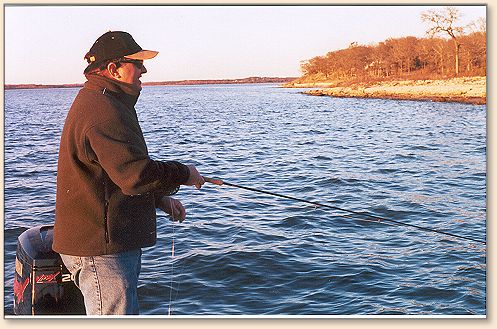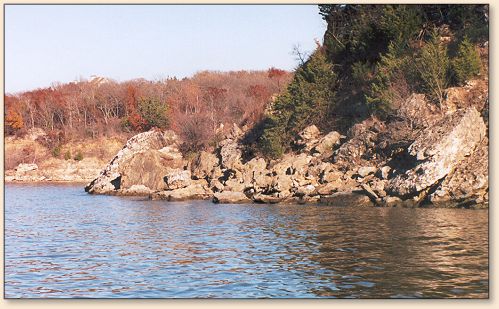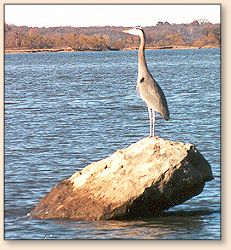|
Lake Texoma is an 88,000 surface acre flood
control reservoir built in the 1940's along
the Texas and Oklahoma border by the Corps
of Engineers. The lake is located about an
hour's drive north of Dallas and about an hour
and half from the DFW airport. The lake is a
popular fishing destination for Striped,
largemouth, smallmouth, white, and even
spotted bass species. The lake recently gave
up a 120 lb Blue catfish and a 130 lb alligator
gar. I don't know about that catfish or the
gar, but the other fish can be caught on a fly
rod.
My experience fishing large reservoirs was
very limited the first time I put a boat in
Texoma, and quite frankly, it was a little
overwhelming. I basically looked around and
thought, "Now what do I do?" This article is
an attempt to summarize what I wish I had known
that day, and hopefully it will be a good
introduction for someone new to the lake. I'm
sure some of you reading this article know a lot
more than I do about Texoma, so write it down and
submit part two of this article to FAOL.
First, some basic details of the lake. It is
located on the Texas and Oklahoma border and
historically these states don't cooperate very
well. That means that they do not recognize
each other's fishing licenses, so to fish both
sides of the lake, you either have to buy both
a Texas and an Oklahoma license, or purchase a
Lake Texoma specific license. In 2004, the Lake
Texoma license was $12. The lake is big and
there can be a large volume of both "pleasure"
and "fishing" boat traffic. Especially in the
summer, watch out for other boats, because every
year someone is killed in a boating accident.
There are a couple of hazards that you need to
be aware of if you bring your boat to Texoma.
One is the weather. Watch out for fast moving
thunderstorms, and watch for high winds. If
the wind speed is over 20 mph think twice about
launching, and use a big boat. While we are on
that topic, some of the bigger boats can create
wakes that are very dangerous to hit while on
plane. These wakes can be difficult to see, so
use caution around those boats. Texoma is not
a real wide lake, but it is long and you can
burn a lot of gas trying to get across it.
Public ramps and marinas are easy to find, so
it is possible to launch close to the area you
plan to fish. Ramp fees range from free to about
$5. Texoma is fishable year round, and crowds
are significantly smaller between Labor Day and
Memorial Day. During the winter, you can have
schools of fish all to yourself.

Most Texoma fishing is done from a boat, but
it is possible to fish from the bank. Two
easy access bank-fishing locations are the
river below the dam and the dam's face. The
Red River holds a variety of species, but if
you want to wade it, you will need an Oklahoma
license because they own the river. The riprap
on the face of the dam can be fished and can be
a good place to find smallmouth bass and
sometimes Stripers.
The crown jewel of Texoma is its Striped bass
population. Stripers reproduce in this lake,
and the population is enormous. The liberal
catch limits reflect the population size, in
2005 - 10 Stripers per day with no minimum
length limit but only two of these fish can
be over twenty inches in length. Texoma may
not be the best choice if you are looking to
catch a "trophy" size Striper, but it is an
excellent choice if you want the opportunity
to catch multiple Stripers. The large
population makes this a good fly fishing
location.
 The techniques for catching Stripers are a
little different than those used for black
bass, although they do overlap. Black bass
tend to stay in a fairly small area and ambush
their prey. Stripers chase their prey and will
roam all over the lake looking for shad. The
"start and stop" retrieve that works so well
with a black bass doesn't usually work with a
Striper. Instead a steady, constant pace often
works better. I think that is because Stripers
are used to chasing shad, and when you are being
chased, you go as fast as you can and you don't
stop. The best retrieve speed varies from day
to day, so experiment until you find a speed the
fish react to.
The techniques for catching Stripers are a
little different than those used for black
bass, although they do overlap. Black bass
tend to stay in a fairly small area and ambush
their prey. Stripers chase their prey and will
roam all over the lake looking for shad. The
"start and stop" retrieve that works so well
with a black bass doesn't usually work with a
Striper. Instead a steady, constant pace often
works better. I think that is because Stripers
are used to chasing shad, and when you are being
chased, you go as fast as you can and you don't
stop. The best retrieve speed varies from day
to day, so experiment until you find a speed the
fish react to.
Stripers spawn in the late January to February
in the rivers. So, there is a little bit of a
seasonal migration of the Texoma Stripers. In
the winter, they tend to be found more on the
western end of the lake toward the Red River,
and then in the summer, more of them are found
near the dam where the water is deeper and cooler.
There is a similar pattern to the north in the
Washita River arm of the lake. With that said,
the Stripers travel so much that you can find
them all over the lake year round, but your odds
of finding fish tend to be better by following
that pattern.
Most Striper fishing on Texoma is done with live
bait and to a lesser extent with large artificial
lures. There are hundreds of guides available
on the lake, and in the summer this creates an
atmosphere where many people "chase the guides."
They will follow the guide boats or use binoculars
to watch other boats to see who is catching fish.
The result is that you will see Texoma "boat shows"
on the lake in the summer where anywhere from 10 to
50 boats will all be fishing the same school of fish.
Personally, I don't like fishing in a crowd. So
in the summer, I tend to fish the early morning
topwater bite, and then I'll go after black bass.
Texoma has enough shoreline that you can always
find a place to fish in peace.

Speaking of topwater, it is a wonderful way to fly
fish for Stripers. The best topwater times are
spring and fall when the Stripers chase the shad
into shallow water. You are looking for wind
blown points preferably near a rapid depth change.
The Stripers will corral the shad against these
points. You really should experience a topwater
Striper strike at least once in your life, but be
warned that it is not for the faint of heart.
The strikes can be subtle where your fly just
disappears and starts heading for China at high
speed, or the lake may explode right in front
of you. Although, the hardest strike on my heart
is the "near miss" where you'll see a bright silver
flash right below your fly and you know a Striper
just changed their mind right before taking your
fly...Ouch! For topwater, cast right on the edge
of the bank, you'll often catch them in less than
one foot of water. If they are away from the bank,
put your fly right in the middle or just past the
center of the circle where a Striper has just been.
Or just fan cast and you'll be surprised when one
appears unexpectedly. Bob's Banger style flies
are good choices to start with and recently, I
have had some luck with Crease flies. Please
note that the topwater bite on Texoma is short,
usually only lasting for an hour or two after
sunrise, so get on the lake early.
Topwater is my favorite, but most Stripers are
caught in the open lake. In the open, I suggest
using a fast sinking line. When you find a school
you will basically fan cast from your boat and
then let your fly sink before starting your
retrieve - the faster your line sinks the more
casts you will be able to make. Let your fly
sink deep. The larger Stripers tend to be deeper
than the smaller Stripers that rise to the surface.
This is why you want a fast sinking line. It takes
way too much patience to wait for a slow sinking
line when you are surrounded by a school of Stripers.
Long casts are also good because they give you more
line in the water to sink and still have a long
retrieve after waiting forever for it to sink to
the right depth. Use baitfish imitations for your
fly choices; Clousers, deceivers, whistlers, etc.
type flies - you want to imitate a shad. The
colors to start with are chartreuse or white or
some combination. Other colors will work and
the casting crowd is even starting to use hot
pink/white and orange/white combinations. So,
again experiment to determine what works that
day. The size of the flies is important. I
tend to use flies, that when laid across the
palm of my hand, will hang over both sides.
One last comment on winter Striper fishing,
Seagulls winter on Texoma so bring binoculars
and watch for them. If you can find feeding
birds, you have just found a feeding school of
Stripers.

The black bass population in Texoma consists of
largemouth, smallmouth, and spotted bass. The
lake was built in the 1940's, so there is no
timber left in the main lake, and you will find
little vegetation. The main bass cover is either
rocks or man-made such as boathouses or the tire
reefs in front of the marinas. When looking for
bass, target rocky points or coves that contain
a lot of rocks. In the heat of the summer, the
shade of the boathouses can be productive,
especially those that are located next to deep
water. The largemouth population seems to be
scattered across most of the lake, but the
smallmouth population is more numerous closer
to the dam. Good areas to search for smallmouth's
include the rocky bank along the Texas state park
and any of the riprap in the dam area. Texoma
is starting to build a reputation for great
smallmouth fishing. The Oklahoma smallmouth
record was caught in 2003 in the Washita arm
of the lake and weighed 7 lb 12 oz. For
largemouth's, I fish rocky points and boathouses
most often. The sandy banks of the islands are
good targets during spawn. However, a summer
time "bikini hatch" tends to disrupt the fishing
around the islands as the weather heats up. Oops!
Back to fishing. As far fly choices are concerned,
all of the standard bass flies seem to work well.
Personally, I'm partial to Calcasieu pig boat's,
olive rabbit strip worm flies, clousers, assorted
baitfish patterns, crawdad patterns, and of course
topwater flies. Just remember that the primary
forage for the bass, just like for the Stripers,
is shad. So, be sure to bring some flies in the
sizes and colors that imitate Shad or baby
Stripers.
If you do get to visit Texoma, DFW is the
closest major airport. Sherman and Denison,
Texas are close to the lake and have a decent
selection of hotels and restaurants, but the
closest fly shop is in Dallas. If you are
coming to Texas or Oklahoma from out of state,
you should try barbecue, some Mexican food, and
around Texoma the fried catfish. The easiest
directions to a catfish restaurant involve
driving across the dam into Oklahoma and looking
to your left as you enter the town. However, my
personal favorite is called "Huck's" and is now
located on highway 75 in Denison.
For equipment, I'd bring a floating line and
a fast sinking line and somewhere around an 8
wt rod to fish the main lake. I use a 7 wt
rod and some folks use 6's and 9's. Just bring
whatever rod you are comfortable casting in the
wind. There are at least two full time fly
fishing guides on the lake; "www.teamgrady.com/fly_fishing.shtml" and "https://www.trinex.net/flyfishing/". Grady's
site also contains several recommended fly
patterns and it is worth visiting. For current
fishing reports, check out the bait fishing reports
on a couple of regional bulletin boards;
"www.sixoldgeezers.com" and "www.texasfishingforum.com".
The 6 old geezers site is maintained by a group
of six retired guys in Oklahoma who go fishing
together almost every day. Gee, retired and
Striper fishing daily, that sounds like a good
plan to me.
Have fun. ~ Rex Walker
|



 The techniques for catching Stripers are a
little different than those used for black
bass, although they do overlap. Black bass
tend to stay in a fairly small area and ambush
their prey. Stripers chase their prey and will
roam all over the lake looking for shad. The
"start and stop" retrieve that works so well
with a black bass doesn't usually work with a
Striper. Instead a steady, constant pace often
works better. I think that is because Stripers
are used to chasing shad, and when you are being
chased, you go as fast as you can and you don't
stop. The best retrieve speed varies from day
to day, so experiment until you find a speed the
fish react to.
The techniques for catching Stripers are a
little different than those used for black
bass, although they do overlap. Black bass
tend to stay in a fairly small area and ambush
their prey. Stripers chase their prey and will
roam all over the lake looking for shad. The
"start and stop" retrieve that works so well
with a black bass doesn't usually work with a
Striper. Instead a steady, constant pace often
works better. I think that is because Stripers
are used to chasing shad, and when you are being
chased, you go as fast as you can and you don't
stop. The best retrieve speed varies from day
to day, so experiment until you find a speed the
fish react to.